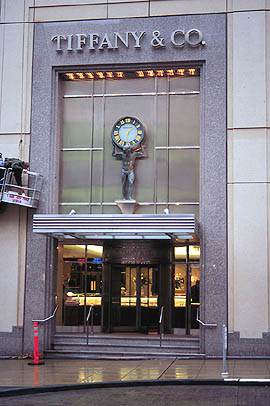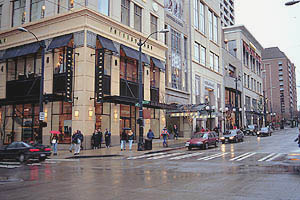|
Subscribe / Renew |
|
|
Contact Us |
|
| ► Subscribe to our Free Weekly Newsletter | |
| home | Welcome, sign in or click here to subscribe. | login |
Commercial Marketplace 1999
|
|
Grace, grandeur and a whole lot of sales
By CLAIR ENLOW Getting Tiffany's, Cartier, Max Mara and Il Fornaio together in Seattle took the right combination of patience, business savvy, charm and architecture. Pacific Place, originally conceived and promoted as a catalyst for the revitalization of downtown Seattle, is also a new link in the evolution of the downtown vertical mall. The challenge of vertical malls is to coax shoppers, many of whom grew up in sprawling suburban malls, into stores located far above street level. Thanks to innovative architecture, vertical malls have succeeded in several cities, giving and taking life from the streets. When Pacific Place opened last October, shoppers came to the block between Pine and Olive streets and Sixth and Seventh avenues to find a small city of storefronts. Inside, a five-story atrium welcomes visitors to roam around inside or pass through to another destination in the city's retail core.
Design credit for Pacific Place is shared by Seattle's NBBJ and Boston's Elkus\Manfredi. NBBJ partner Bill Bain was there at the beginning, when the lights went out at Frederick & Nelson next door and other long-time retailers were packing to leave. Bain worked on renovation of the Olympic Four Seasons Hotel with Pacific Place's original developer, Jeff Rhodes. Their conversations led to talk of doing a three-block land swap and redevelopment that included renovating Frederick & Nelson for Nordstrom and developing Pacific Place. Pieces of the program for Pacific Place were laid out at that time, including the requirement that it strengthen the entire downtown retail core. Six years later, Bain is pleased with the outcome. On a recent evening, Bain said, the bartender at a nearby restaurant told him he's seen a three-fold increase in business since Pacific Place opened. Bain saw crowds crossing Pine Street that evening, at a time of day the intersection would have been empty a few years ago. According to Bain, the magic of the project lies in its ability to attract people without entrapping them. Department stores and malls have relied for too long, he said, on strategies for capturing customers and herding them past merchandise. There is little economic incentive for getting daylight into a mall, because that typically involves sacrificing leasable space. Pacific Place and other vertical malls have turned these assumptions about retail around. Unlike in a department store or suburban mall, there must be plenty of opportunities and incentives to go to the upper floors. Increasingly, circulation both inside and outside is the key to success. How are we going to make the circulation work? was one of the first questions for the developers and the architects. Their answer was to get a lot of people looping their way through, said Jane Lewis of Pine Street Associates. Nordstrom expresses what it is: a huge department store, said architect Howard Elkus of Elkus/Manfredi. Signature merchants like those at Pacific Place need something different he said, and so did Seattle. That something is what Elkus calls connectivity. From the street, connectivity is found in the number and variety of entrances. There are many individual store entrances which also lead into the complex itself. In two-level stores shoppers can circulate up or down before entering the center. And there are also main entrances that lead directly into the center. All of them provide choices. Even the underground parking garage has a presence on the street. What we have created is an entrance with all the dignity of a great hotel, said Elkus. When you go into the garage to one of the six levels of parking, you're not just going into a basement. After you park, you enter the complex through a special, below-grade concourse level. The whole arrangement gives a front door to merchants who occupy the concourse level, noted Elkus. A skybridge on the third level lets crowds move easily between Pacific Place and the new Nordstrom store. Pacific Place truly represents the paradigm of the vertical retail, dining and entertainment experience. It's the state of the art. And it represents the learning of individuals that have been on this trip for over 35 years, said Elkus. Elkus counts Watertower Place in Chicago, built in 1970, as the first in its category: a vertical retail with several levels of storefronts opening onto a central atrium with a water feature. Then came Copley Place, a mixed-use retail and hotel project in Boston that made several key connections to surrounding streets. Chicago's 730 North Michigan, just completed last year, gave tenants their own street entrances and strong exterior presence.
Bill Bain and Howard Elkus have been friends for some time, and welcomed the chance to work as a team when the Pacific Place developers picked both firms. Despite the lineage Pacific Place shares with the developers' earlier work, it also represents something about the city, said Elkus. We are all very conscious of the need to make this Seattle's project. Localizing the project began at the top, with the skylight. Sunlight is a precious thing, Elkus said. We have made it psychologically one of the amenities that bring people here. Elkus likens the visitor's experience to that of being in a European galleria. Capping the interior courtyard with a skylight floods each facade with daylight. It is an essential part of the streetscape strategy, and a new step in the development of the vertical mall, according to Elkus. It all contributes to the sense that you are part of the city, he said. And that means that every shop inside essentially has an exterior address. Everything else follows, said Elkus. The light posts. The paving. The cafe. The presentation of Il Fornaio is not of an interior restaurant. It is treated as if it could be in a great public square. All of the pieces are there so that you don't break the continuity from Pine to Olive. In Pacific Place, vertical circulation becomes another opportunity to give visitors a sense of ownership, according to Elkus. As they ride on escalators that sweep up the wall of the atrium, they are exposed to excitement and opportunity at each level. The openness and the long curved wall give riders views of many storefronts at once, while producing the effects of a city square and an amphitheater.
And it's working. They're getting the top of the market, Owen said, competitive with any rate nationally with the exception of New York and Chicago. But until very late in the game, with Pacific Place well under construction, the final mix of tenants was very much in question, according to Jane Lewis of developer Pine Street Associates. For the retailers that greeted Seattle when Pacific Place opened, being shut inside a big box was out of the question. Cutter & Buck was one of those tenants who made the decision last year to open its first retail store at Pacific Place. The 10-year-old company, which sells its own line of golf-inspired clothing through pro shops and resorts throughout the U.S., was beginning to look for the right place to open a retail store while Pacific Place was under construction. We wanted to be downtown because we saw a vibrancy and revitalization there, said Vice President Jeff Buchman. Pacific Place seemed not so much a shopping center as a social destination. We paid the site a visit in April, when it was just a skeleton, he said. We very much liked the open space of it, the concept of bringing the street into the interior. We were very impressed with the other tenant partners that we would be associated with. We could see an easy fit between their customer base and our customer base. One of the big attractions to retailers, according to Owen, is stores with doors on the sidewalk. That sounds so obvious, but it is actually a very big deal. The expression on the street is of great retail stores. There is no clue of the whole, said Elkus. We really liked the idea of having a two-story facade, said Tiffany store director Detra Segar. It gives us a wonderful presence on the block. Segar especially likes the way the windows at the back open out into the courtyard area. Have you been to Milan? she asked. It's really like the Galleria there even on the grayest days. It always appears like it's bright. Instead of a water feature, what Seattle has is a sunlight feature.
 djc home | top | special issues index
|



